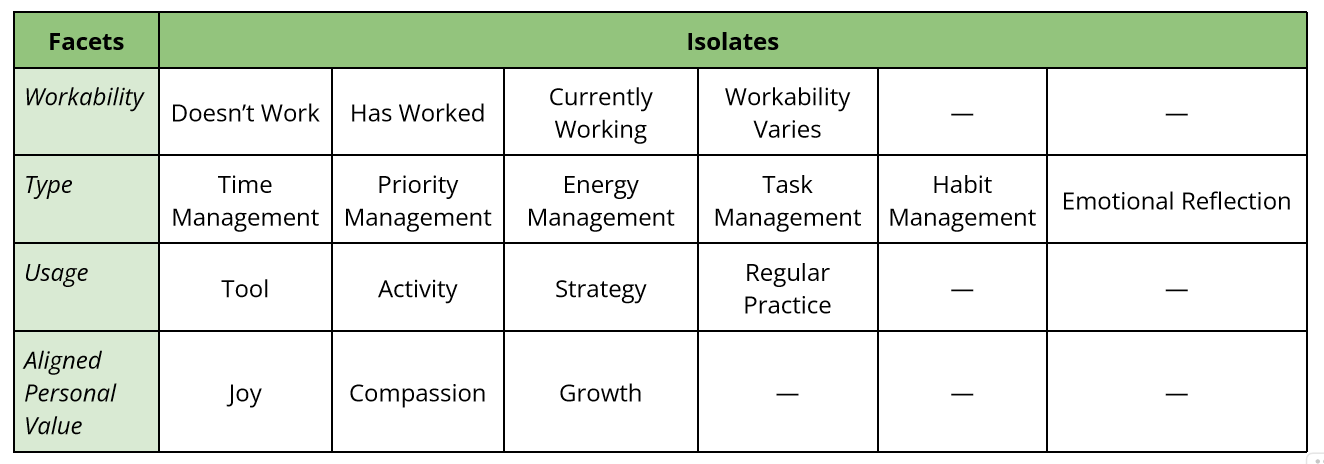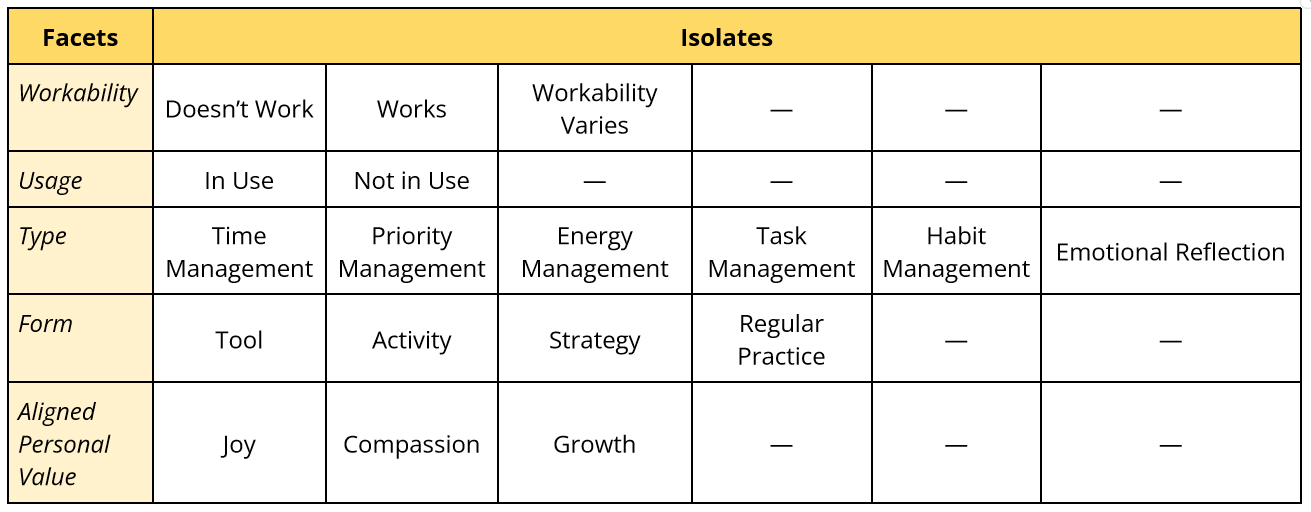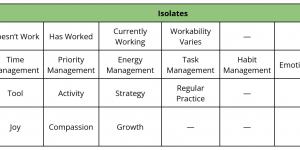Creating the System
A faceted classification system created from scratch in Google Docs in about two to three hours.
I chose to work with a list of productivity methods and tools that I have or am currently using. My needs for methods and tools change based on my context (e.g., am I in school?), and only being able to track what does and doesn't work didn't take that into account. I have also been working to better incorporate more of my core values into my life, and so I included that as a facet for this system.
I first listed ways I would describe each method or tool to someone else if I were trying to help them decide what to use. From there, I grouped like descriptors (e.g., type, usage) and made them into facets.

As noted in the footnote of my original design, this system is inspired by Jessica McCabe (HowToADHD)’s “ADHD Toolbox” on Notion.
Receiving Peer Feedback
A recurring idea in the peer feedback I received after submitting my assignment was that the "Workability" facet had two ambiguous isolates: "has worked" and "currently working."
One thing I was not 100% clear on was the difference between “has worked” and “currently working” since both seem like they could mean “this has worked at least once but might stop working.” (Peer Reviewer #2)
However, "has worked" can also be interpreted as worked in the past, but no longer works at the moment (in which case, this would maybe fall under "doesn't work," so there might be a bit of overlap between isolates). (Peer Reviewer #3)
The reviewers rightfully pointed out that these isolates created a bit of a contradiction: either I had isolates that were not exclusive to each other, or I had isolates that were trying to describe two attributes (i.e., whether it worked and whether it was in use).
Revising My Work

Based on the comments noted above, I renamed the Usage facet as "Form" and used the label of "Usage" to add a new facet that encompassed the idea of current usage so that the Workability isolates would not be trying to explain two attributes at once.
Giving Peer Reviews
Each of us was assigned 3 others for a peer review shuffle. For my reviews, I focused on mutual exclusivity among isolates and whether a system could function without needing revisions as new entries were added. In some cases, I also considered the user group in my comments. As suggested by the instructing team, some comments were written as questions so as not to frame myself as an expert.
...At the moment, I would not be able to categorize a [person] from the United States. (to Review Recipient #1)
...I noticed you had <5.5 km but not >25.5 km--does [the service you based this on] not have routes that exceed that length, or do you not expect them to be popular enough to be added to the data set? (to Review Recipient #2)
I am basing my comments on the idea that the items to be classified are things you will want to buy. ... Since you likely buy the same size clothes for most situations, I wonder if it is a helpful facet for this use case... Is this for situations where a brand might have "XL" for what you would normally call a "Medium"? (to Review Recipient #3)
From giving these reviews, I got better sense of what factors I might consider when evaluating classification systems in my future work.
iSchool Graduate Competencies
Below is a self-identified list of competencies that this activity engages as it aligns with the iSchool MLIS Graduate Competencies:
3. Organize and manage information to facilitate access, reflection, and use in a range of contexts
6. Communicate clearly using a range of media suited to diverse audiences and goals
9. Develop respectful reciprocal relationships with professional and community groups

Faceted classification systems are frequently used to organize information in everyday life, including online shopping platforms. I take from this experience an ability to better assess and design faceted classifications of my own in personal and professional settings. It also helped me to develop skills in giving and receiving kind and constructive feedback. As most library work is related to communicating with supervisors, peers, and subordinates, this is a key skill.